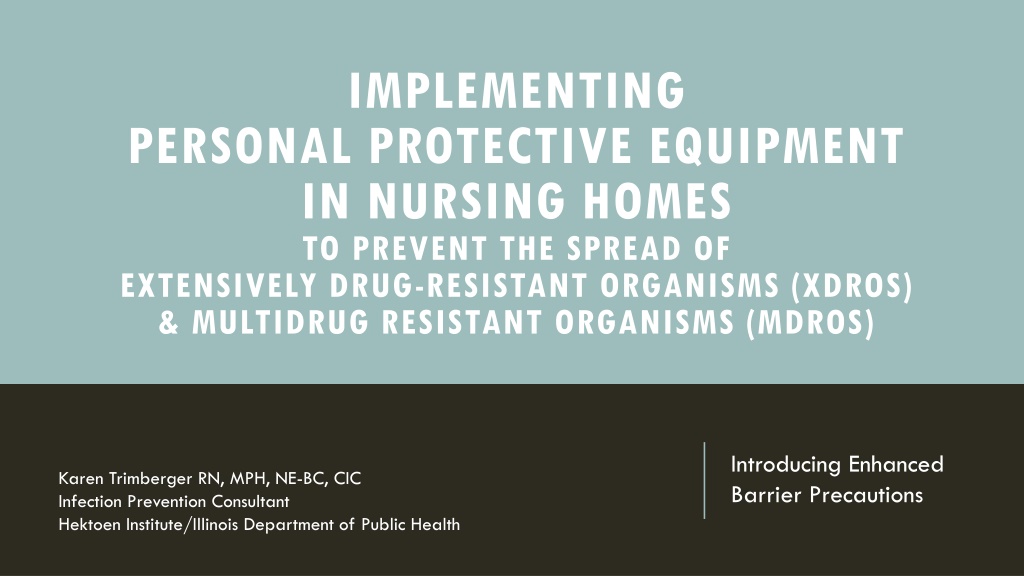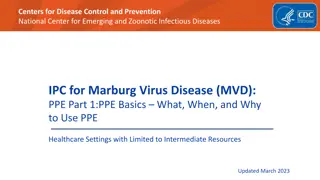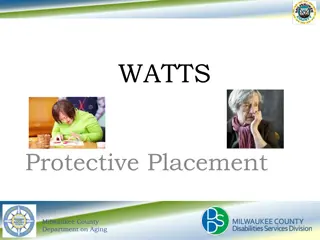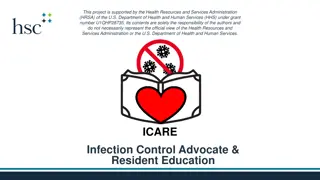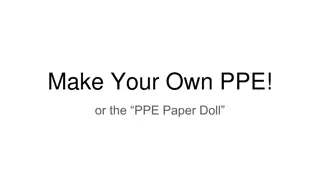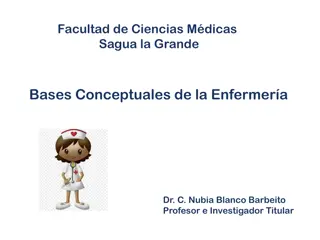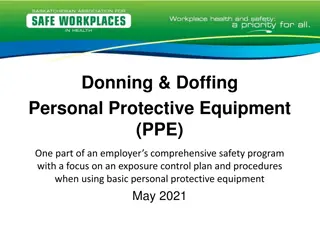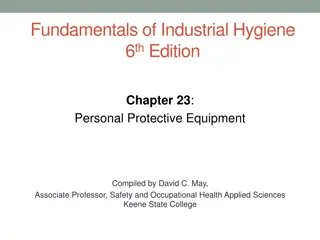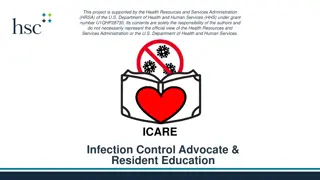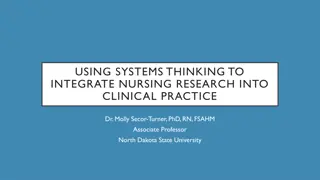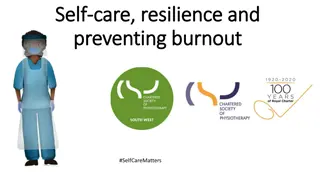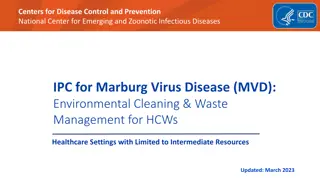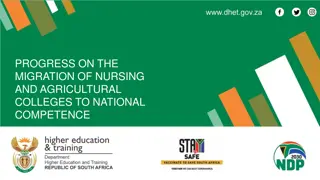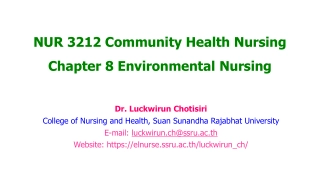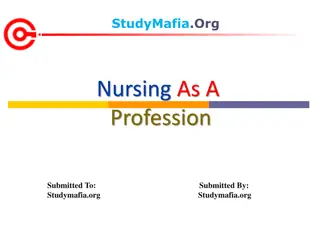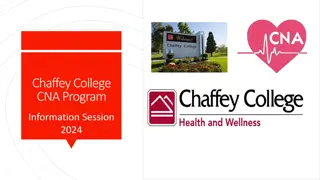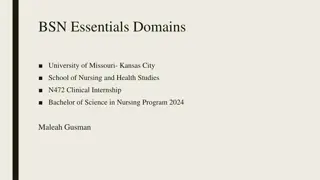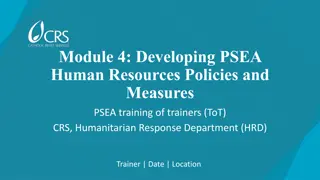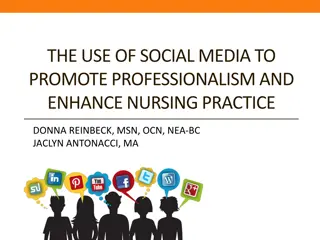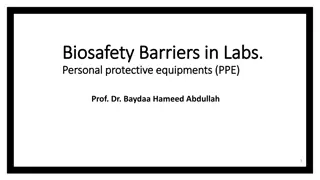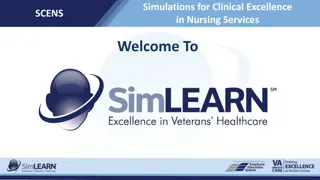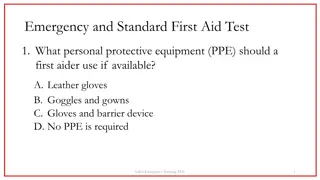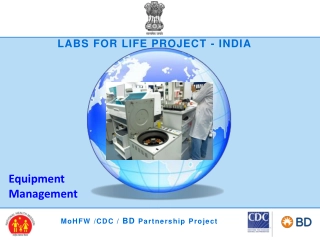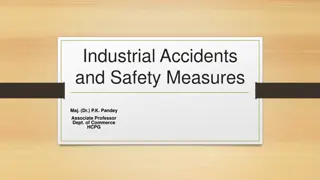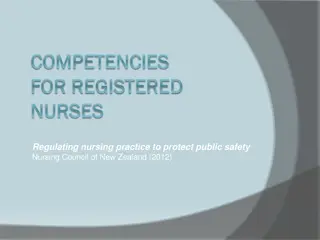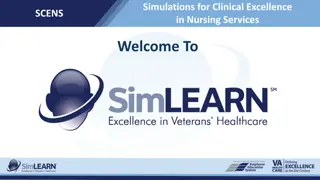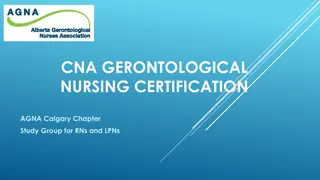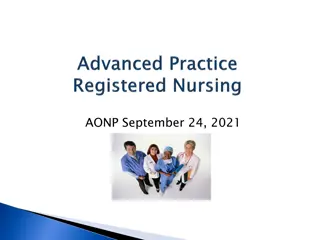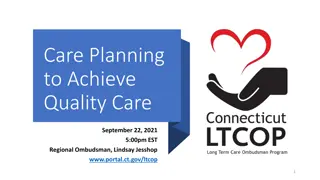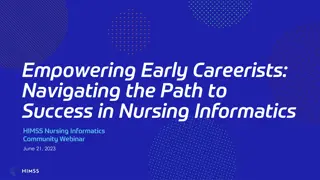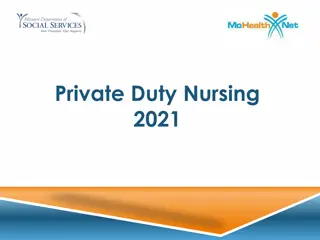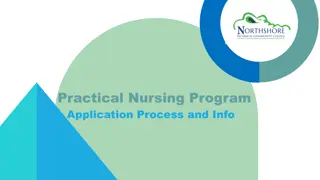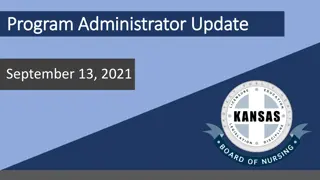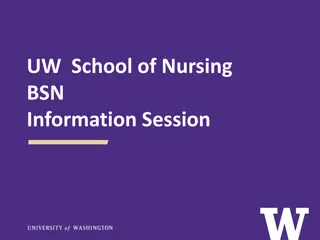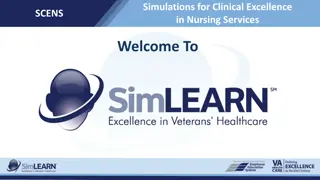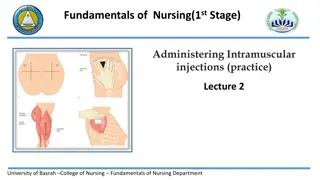Implementing Personal Protective Equipment in Nursing Homes for Preventing XDROs and MDROs
Learn from infection prevention consultant Karen Trimberger about implementing enhanced barrier precautions in nursing homes to prevent the spread of extensively drug-resistant organisms (XDROs) and multidrug-resistant organisms (MDROs). Explore the difference between colonization and clinical infections, review standard and contact precautions, identify appropriate personal protective equipment, and understand the impact of multidrug-resistant organisms in long-term care facilities.
Download Presentation

Please find below an Image/Link to download the presentation.
The content on the website is provided AS IS for your information and personal use only. It may not be sold, licensed, or shared on other websites without obtaining consent from the author. Download presentation by click this link. If you encounter any issues during the download, it is possible that the publisher has removed the file from their server.
E N D
Presentation Transcript
IMPLEMENTING PERSONAL PROTECTIVE EQUIPMENT IN NURSING HOMES TO PREVENT THE SPREAD OF EXTENSIVELY DRUG-RESISTANT ORGANISMS (XDROS) & MULTIDRUG RESISTANT ORGANISMS (MDROS) Introducing Enhanced Barrier Precautions Karen Trimberger RN, MPH, NE-BC, CIC Infection Prevention Consultant Hektoen Institute/Illinois Department of Public Health
Digitallearning.eletsonline.com Review the difference between colonization and clinical infections. Review standard and contact precautions and introduce enhanced barrier precautions. Describe the impact of multidrug resistant organisms in long-term care facilities. Identify appropriate personal protective equipment (PPE) to use for each precaution based on the type of activity being performed. Examine when room restrictions are warranted.
Colonization/Infection Standard Precautions Personal Protective Equipment (PPE) A REVIEW OF THE BASICS
COLONIZATION Microorganisms (e.g., bacteria, fungi) are present on or in the body but are not causing disease. Bacteria or fungi are present without evidence of infection.
INFECTION Active process where microorganisms (e.g., bacteria, fungi) are causing harm to the body. Carbapenem-resistant enterobacteriaceae Bacteria or fungi have grown and the person is displaying symptoms from them. Americansecuritytoday.com
STANDARD PRECAUTIONS A group of infection prevention practices that apply to all patients, regardless of suspected or confirmed infection status, in any setting in which health care is delivered. Standard Precautions are based on the principle that all blood, body fluids, secretions, and excretions (except sweat) may contain transmissible infectious agents. Hand hygiene Use of personal protective equipment (e.g., gown, gloves, masks, eyewear) Respiratory hygiene / cough etiquette Sharps safety (engineering and work practice controls) Safe injection practices (i.e., aseptic technique for parenteral medications) Sterile instruments and devices Clean and disinfected environmental surfaces
PERSONAL PROTECTIVE EQUIPMENT (PPE) Use of PPE is based on the staff interaction with residents and the potential for exposure to blood, body fluid, or pathogens (e.g., gloves are worn when contact with blood, body fluids, mucous membranes, non- intact skin, or potentially contaminated surfaces or equipment are anticipated).
WHY ENHANCED BARRIER PRECAUTIONS? Contact Precautions alone has failed to control the transmission of multidrug-resistant organisms in nursing homes. Facilities need an approach to gown/glove use that is less restrictive than Contact Precautions and can be sustained for prolonger periods of time. A category of TBP that balances patient-centered care and risk.
How do we know Contact Precautions alone has failed to control the transmission of multidrug-resistant organisms in nursing homes?
WHY HAS CONTACT PRECAUTIONS FAILED TO STOP THE SPREAD OF MDROS? Many nursing homes residents are unknowingly colonized with an MDRO, especially those residents with risks factors like wounds and indwelling medical devices. Residents with MDRO remain colonized for long periods of time and can spread MDROs to others. Unfortunately, MDROs are spread by health care personnel (HCP) through contaminated hands and clothing. Not all HCP follow procedures appropriately for TBP and consequently they are transferring the MDROs from one resident to another resident.
EBP BALANCES PERSON-CENTERED CARE & RISK? Person Risk Centered Care Courtesy of Deb Burdsall Patient-centered Residents need to socialize and to participate in communal dining, group activities. Isolation is scary and can be stigmatizing if required to stay in their room and not come out unless medically necessary. Residents on Enhanced Barrier Precautions are not restricted to their rooms and may leave their room to participate in communal dining and group activities. Risk Does the resident have an indwelling medical device, open wounds, or are they immuno- compromised? EBP helps protect residents at risk for acquiring colonization (those with wounds, indwelling devices, etc.).
Transmission- based Precautions Enhanced Barrier Airborne Droplet Contact Explaining the Difference between Contact Precautions and Enhanced Barrier Precautions TRANSMISSION-BASED PRECAUTIONS
TRANSMISSION-BASED PRECAUTIONS Transmission-Based Precautions (TBP) are for residents who are known or suspected to be infected or colonized with infectious agents, including certain epidemiologically important pathogens, which require additional control measures to effectively prevent transmission. TBP are intended to prevent transmission of infectious agents, including epidemiologically important microorganisms, which are spread by direct or indirect contact with the patient or the patient s environment. https://www.cdc.gov/infectioncontrol/pdf/guidelines/isolation-guidelines-H.pdf
Transmission- based Precautions Enhanced Barrier Airborne Droplet Contact ENHANCED BARRIER PRECAUTIONS What are EBP? (EBP)
WHAT ARE ENHANCED BARRIER PRECAUTIONS (EBP)? EBP expands the use of PPE beyond situations in which exposure to blood and body fluids is anticipated. EBP falls between standard precautions and contact precautions on the continuum of care. EBP requires the use of gown and gloves when performing high-contact resident care activities. Gown and gloves are not required when NOT performing a high contact activity. EBP offers better protection for the resident (prevention of colonization or infection). Intended to be used during the resident s entire stay (or until wound heals or medical device is removed). Enhanced Barrier Precautions Precautions Contact Precautions Standard
WHAT ARE HIGH-CONTACT RESIDENT CARE ACTIVITIES Dressing Bathing or showering Transferring Providing hygiene Changing linens Changing briefs or assisting with toileting Device care or use (urinary catheters, feeding tubes, tracheostomy/ventilator, central lines) Wound care (requiring a dressing)
INTENDED TO BE USED FOR THE RESIDENT S ENTIRE LENGTH OF STAY or UNTIL THE WOUND HAS HEALED OR THE DEVICE IS REMOVED ENHANCED BARRIER PRECAUTIONS-- WHAT S REQUIRED? Enhanced Barrier Precautions (EBP) Signage Post on doorframe and above bed if resides in multi-occupancy room Hand hygiene Hand hygiene EVERY TIME Personal Protective Equipment Gown and gloves EVERY TIME with high-contact activities Communal Dining and Group Activities May Participate Private or Single room Not required We are trying to prevent the transfer of organisms to staff hands and clothing.
Transmission- based Precautions Enhanced Barrier Airborne Droplet Contact CONTACT PRECAUTIONS (CP) What are CP?
OLDCONTACT PRECAUTIONS VS. NEW CONTACT PRECAUTIONS Gracetruthwindsor.com
THE OLD CONTACT PRECAUTIONS Contact Precautions in long- term care facilities often allowed residents to come out of their rooms and participate in communal dining and group activities if the wound or drainage could be contained.
THE NEW CONTACT PRECAUTIONS Residents will be required to stay in their rooms unless medically necessary to come out. The resident should not participate in communal dining and group activities. Homemate-.com
Contact Precautions should be used: All residents with draining wounds that cannot be contained (e.g., who cannot maintain adequate hygiene) and/or diarrhea, regardless of MDRO status. On units or in facilities where ongoing transmission is documented or suspected. For infections (e.g., C. difficile, norovirus, scabies) and other conditions where Contact Precautions is recommended by the CDC.
CONTACT PRECAUTIONS--WHATS REQUIRED? Contact Precautions (CP) Signage Post on doorframe Each bed treated as private room in multi- occupancy rooms Hand hygiene Hand hygiene EVERY TIME Personal Protective Equipment Gown and gloves EVERY TIME Equipment Dedicated or disposable Reusable-clean and disinfect Communal dining and group activities Not allowed. Dining and activities should occur in resident s room only. Private or single room Preferred. May cohort like organisms. Follow Cohorting Guidance and consult with local health department.
Transmission- based Precautions Enhanced Barrier Airborne Droplet Contact DETERMINING WHAT TYPE OF Should I use EBP or Contact Precautions??? TRANSMISSION-BASED PRECAUTIONS TO USE
CDC RECOMMENDATIONS FOR EBP STATEMENT from the CDC Implementation of Personal Protective Equipment (PPE) Use in Nursing Homes to Prevent Spread of Multidrug-resistant Organisms (MDROs) guidance that needs to be emphasized: MDROs for which the use of EBP applies are based on local epidemiology. At a minimum, they should include resistant organisms targeted by CDC but can also include other epidemiologically important MDROs. https://www.cdc.gov/hai/containment/PPE-Nursing-Homes.html
DETERMINING THE TYPE OF PRECAUTIONS TO USE When determining which type of Transmission-Based Precautions to use among residents in long-term care facilities, facilities should consider using one or more of the following approaches, keeping in mind that Standard Precautions should be used on all residents during all care: PATHOGEN-BASED APPROACH RISK-BASED APPROACH Clipartcraft.com
PATHOGEN-BASED APPROACH Pathogen-based: a) XDROs: EBP may be used for residents with an XDRO unless the resident has draining wounds that can't be contained (e.g., residents who cannot maintain adequate hygiene) and/or diarrhea, in which case Contact Precautions would be indicated. b) MDROs: A facility should use a risk-based approach to determine what type of precautions (Contact or EBP), if any, are warranted for a resident colonized or infected with MDROs. A risk- based approach takes into consideration the resident s clinical situation, and the prevalence or incidence of MDROs in the facility. Consider this approach for residents with organisms not previously encountered in the facility.
RISK-BASED APPROACH Risk-based: a) Use EBP for residents with wounds requiring dressings (e.g., pressure ulcers, diabetic foot ulcers, unhealed surgical wounds, and chronic venous stasis ulcers) UNLESS the drainage from the wound cannot be contained (e.g., residents who cannot maintain adequate hygiene), or the resident is colonized or infected with an infection or condition listed in CDC s Guideline for Isolation Precautions Appendix A where Contact Precautions are recommended. b) Use EBP for residents with any indwelling devices (e.g., central lines, urinary catheters, feeding tubes, hemodialysis catheters, tracheostomies, and ventilators) UNLESS the resident is colonized or infected with an infection or condition listed in CDC s Appendix A where Contact Precautions are recommended.
WOUNDS REQUIRING A DRESSING WHAT TYPE OF WOUNDS ARE WE TALKING ABOUT? CDC does not typically include a skin break/tear that would be covered by a band- aid or another type of dressing similar to a band-aid as a wound requiring a dressing. CDC consider the following as wounds requiring a dressing pressure ulcers diabetic foot ulcers unhealed surgical wounds other wounds, such as chronic venous stasis ulcers. These are surgical wounds that aren t healing NOT a fresh post-op surgical wound for total joints, etc.
INDWELLING MEDICAL DEVICES WHAT TYPE OF MEDICAL DEVICES ARE WE TALKING ABOUT? CDC defines indwelling medical devices as those that communicate to the outside. CDC would not classify a dialysis fistula as an indwelling medical device if it has healed, but it does include hemodialysis catheters that have direct access to the outside. CDC considers the following as indwelling medical devices central lines urinary catheters feeding tubes hemodialysis catheters tracheostomies ventilators An ostomy or stoma (fresh or mature) are NOT an indication for EBP.
HOW TO IMPLEMENT EBP Provide EBP education and training to staff. Validate competency of staff on PPE use for EBP. Start Slow! (e.g., start with one unit and ensure everyone understands the principles of EBP before moving to the next unit). Select a unit that has a higher burden of XDROs or MDROs or a unit where ventilators or trach residents reside. Consider using the CDC Pre- implementation tool for EBP to assess readiness. Redbubble.com
RESOURCES Pre-Implementation Tool Enhanced Barrier Precautions (EBP) https://www.cdc.gov/hai/pdfs/containment/Pre-Implementation-Tool-for-Enhanced-Barrier-Precautions-508.pdf Implementation Guide https://www.cdc.gov/hai/containment/PPE-Nursing-Homes.html FAQS https://www.cdc.gov/hai/containment/faqs.html PowerPoint Presentation by CDC https://view.officeapps.live.com/op/view.aspx?src=https%3A%2F%2Fwww.cdc.gov%2Fhai%2Fpdfs%2Fcontainment%2FEBP-Presentation- July2022.pptx&wdOrigin=BROWSELINK Letter to share with residents and families https://www.cdc.gov/hai/pdfs/containment/Letter-Nursing-Home-Residents-Families-Friends-508.pdf Letter to share with staff https://www.cdc.gov/hai/pdfs/containment/Letter-Nursing-Home-Staff-508.pdf YouTube Video from CDC on Implementation of Enhanced Barrier Precautions https://www.youtube.com/watch?v=WD87c4PP6pE&list=PLvrp9iOILTQayOi5lgk08QDgv3GHROtCf&index=23 Enhanced Barrier Precautions (EBP) Implementation Observations Tool https://www.cdc.gov/hai/pdfs/containment/Observations-Tool-for-Enhanced-Barrier-Precautions-Implementation-508.pdf
QUESTIONS? Contact your local health department or regional IDPH infection preventionist Stock.adode.com ILLINOIS DEPARTMENT OF PUBLIC HEALTH
